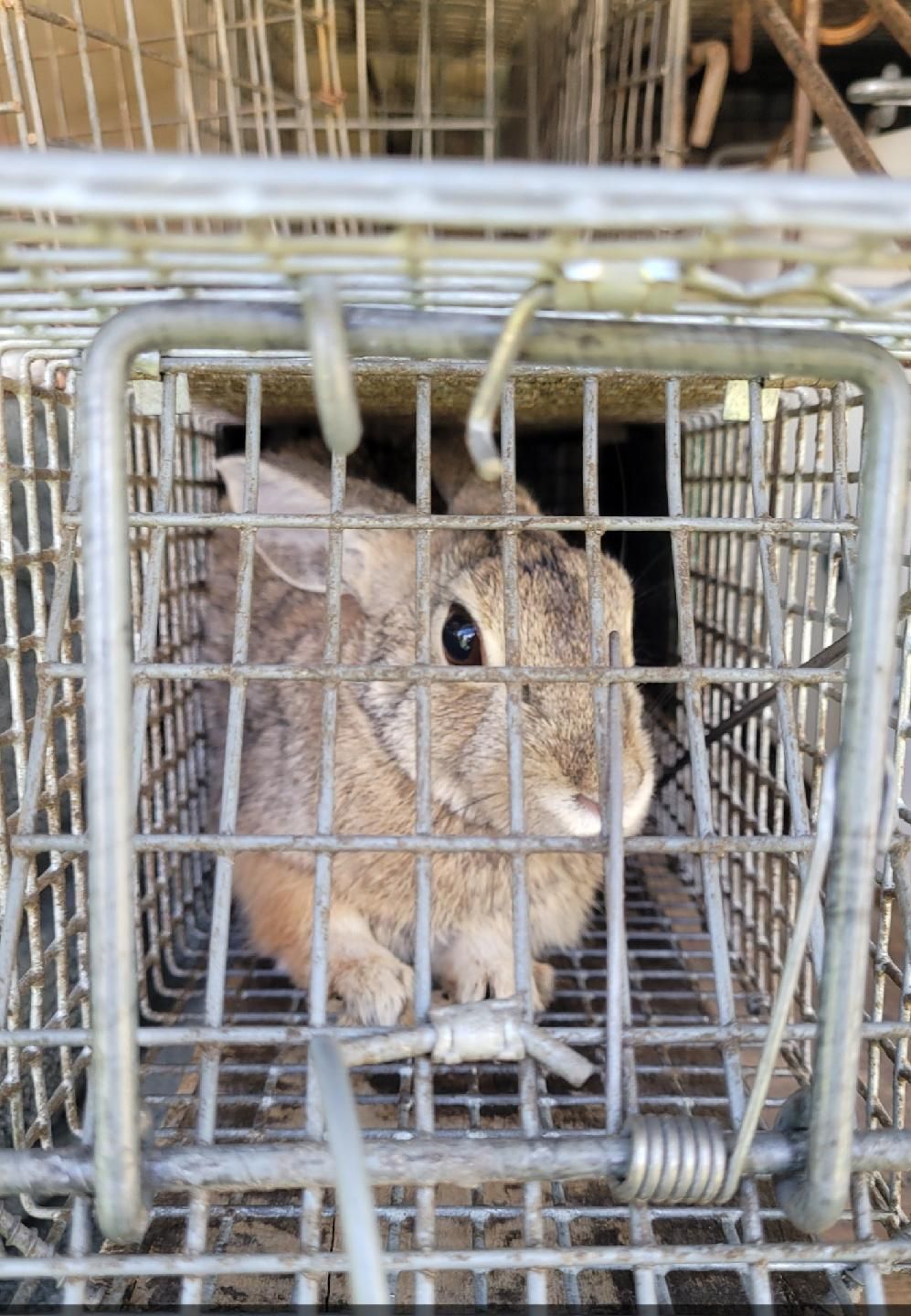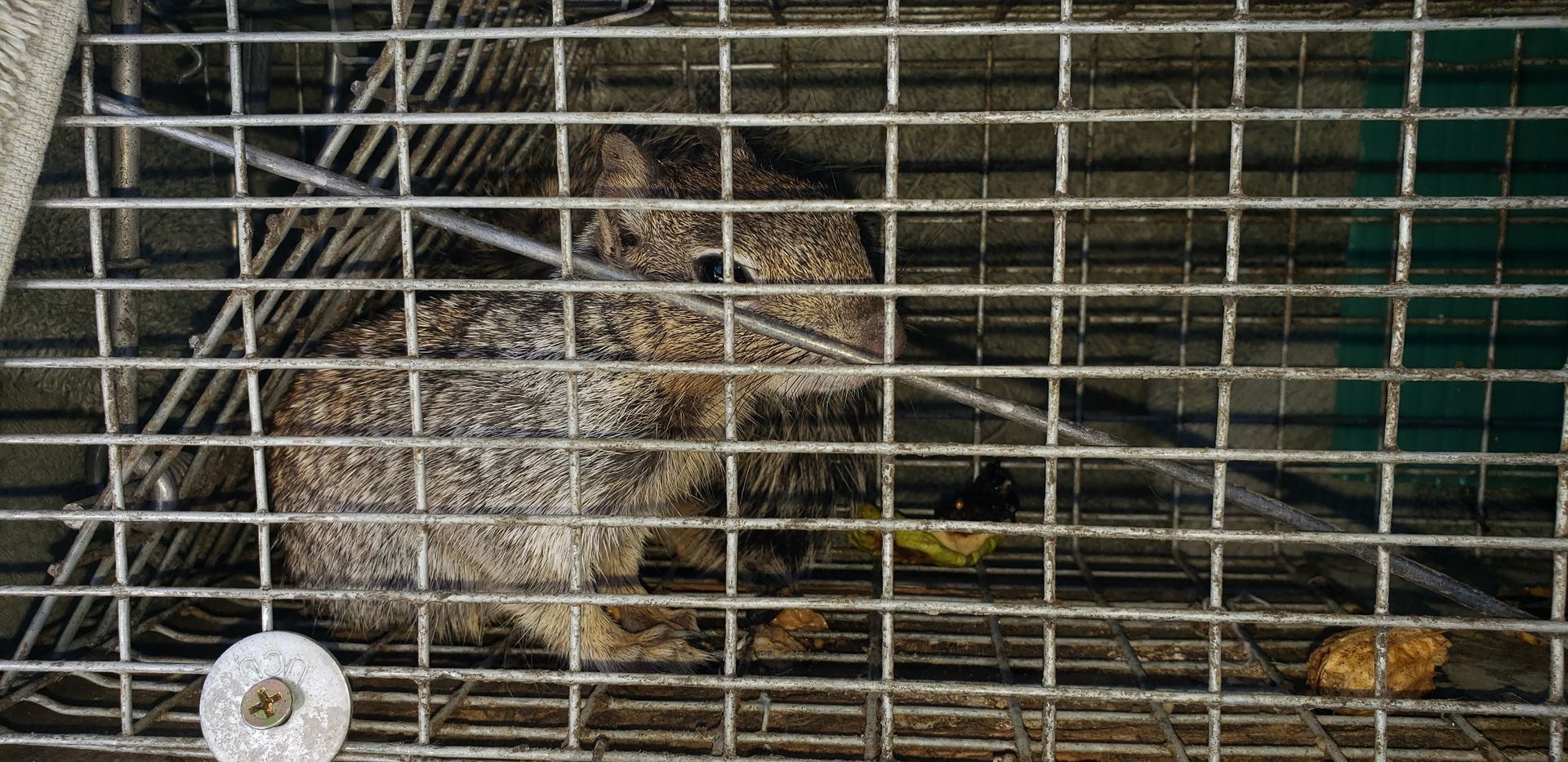Wildlife Access Exclusion
Rabbit Control and Exclusion
Rabbits, hares, and pikas resemble rodents but have some differences in morphology and diet (mostly grasses and herbs). They are called lagomorphs. Two species of rabbits are common locally: the desert cottontail (Sylvilagus audubonii) from the foothills east and the mountain or Nuttall’s cottontail (Sylvilagus nuttallii) from the foothills west at higher elevations. They are prolific breeders, having 3-5 litters between March and September. They can be a nuisance by chomping on flowers and vegetables, living in/under structures, and sometimes getting trapped and dying in/under structures. Two species of jackrabbits (eastern grasslands), the diminutive pika (above 10,000 feet) and snowshoe hare (high conifer forests), live in the region but are rarely a nuisance.
Cottontails can be controlled somewhat by shooting with pellet air guns or .22 rimfire firearms where appropriate and safe. Live trapping with box traps or cage traps can be effective in harsh winter conditions when food is scarce, but otherwise is inefficient. Rabbits generally have too much food available to be enticed into a trap with baits. However, box or cage traps work well when rabbits can be funneled into them in travel-ways or when used as one-way devices over rabbit access points under decks, sheds, patios, etc. Exclusion repairs to prevent rabbits from having access in such cases can go a long way toward reducing rabbit problems. We can provide any of these services.
We’ll have more information about rabbit biology, problems they pose, and solutions we offer coming soon. In the meantime, if you have a rabbit problem, call us at
719-636-1014 for an assessment and prices.
Skunk Removal and Exclusion
Two species of skunks occur locally: the very familiar striped skunk and the much lesser-known western spotted skunk (or civet cat).
The striped skunk (Mephitis mephitis), of “Pepe le Pew” fame, is native to Colorado and very common locally in some areas. They are about the size of a housecat but much more stocky and compact. They are jet black in color, typically with two white stripes down the back, with a very bushy black and white tail. The peak of the breeding season is February locally, with rather large litters of 6-8 young being born in early May. Skunks are classified as carnivores, but are really omnivores in diet, eating most anything: insects, grubs/worms, mice, fruits, grain/seeds, pet food, garbage, etc. They love bird feeders! Although some neighborhoods have plenty of skunks, the overall local population has been reduced significantly in recent years due to increased vehicle traffic, periodic outbreaks of distemper and the Colorado Division of Wildlife requirement that skunks cannot be relocated. Due to the history of rabies in skunks and the recent re-occurrence in Colorado, captured skunks must be released or dispatched (i.e., euthanized) at the capture site. They cannot be transported to another location and released. Skunks are largely nocturnal and crepuscular (i.e., active at dusk or dawn).
The western spotted skunk (Spilogale gracilis) is smaller than its striped cousin and has pretty white splotches instead of the classic stripes. They, too, are omnivores, but are much more quick and agile predators than striped skunks. They are fairly common in the foothills and rocky areas up to 9,000 feet. They tend to breed in the fall, with litters being born in May.
In the wild, skunks dig and use earthen dens, but in suburban/urban areas it’s much more common for them to live under settled concrete (e.g., steps, patios, porches), in unfinished crawl spaces under homes (e.g., old homes, cabins, modulars), and under storage sheds. Telltale evidence of striped skunks is typically a half-moon shaped “dig-under,” roughly 10-12” wide and 4-5” deep. These classic dig-unders also indicate where skunks are entering a fenced yard. Striped skunks are not climbers.
If it weren’t for the potent, very offensive odor of a skunk’s anal gland fluid, most people would not consider them to be a nuisance. Unfortunately, the yellowish, oily, sulfurous fluid that is ejected quite powerfully and accurately can wreak havoc. It’s quite common for pets to get sprayed, for skunks to squabble and spray under someone’s home, or for one to die and decompose under a shed or mobile home. Fortunately, most skunks are rather passive and only spray when startled or seriously threatened. Skunks also get into trouble when they dig (or “grub”) for worms in sod, fall into window wells, or enter pet doors.
Disease also raises concerns about skunks. For example, distemper, though not contagious to humans, can cause unusual behavior. Skunks with advanced symptoms of distemper are often active during daylight and act sick, lethargic, and disoriented. Their eyes and noses are often crusty-looking. They are not usually aggressive. Skunks with rabies may exhibit similar symptoms but can be much more aggressive towards pets and people. The disease is transmitted by saliva through a bite. In cases of close contact, the skunk should be contained and the incident reported to the Environmental Section of your local health department as soon as possible. The Colorado Division of Wildlife, Humane Society (i.e., local animal control), or private companies like Alpine Animal Control can help with the capture and submission of the skunk for testing.
If you suspect striped skunks are living on your property, our approach to control typically includes 1) an investigation to confirm presence and find points of entry; 2) setting specialized skunk live traps at entry points; 3) capturing, euthanizing, and disposing of resident skunks; 4) monitoring entry points to ensure that skunks are no longer living there; and 5) repairing/excluding entry points to both look good and permanently keep skunks out when practical. Similar steps are used to locate and remove dead skunks. Various odor solutions are included as necessary. We also remove skunks from window wells and can provide on-the-spot captures of sick or injured skunks.
If you need help with a skunk problem, call us at
719-636-1014 for an investigation and prices. We’d be happy to help.
Tree Squirrel Control & Exclusion
Three species of tree squirrels are found in the Pikes Peak Region: the Eastern fox squirrel, the pine squirrel (or chickaree), and the Abert’s (or tassel-eared) squirrel.
The Abert’s squirrel (Sciurus aberti), with its prominent ear tufts, is native to the region and is always ecologically tied to ponderosa pine forests at elevations of 5,600 to 9,000 feet (e.g., Black Forest). They have three color phases, the most common being jet black. Aberts ’are rarely a nuisance to people.
Pine (or “spruce”) squirrels (Tamiasciurus hudsonicus) are the small, noisy squirrels native to spruce/Douglas-fir forests at elevations of 6,000 to 12,000 feet. These feisty little guys, with their characteristic rapid-fire chatter, are typically grayish olive-brown in color, with a distinctive white eye ring. It’s not uncommon for them to be a nuisance by choosing to live in attic crawl spaces, particularly up Ute Pass and places west. Common damage includes gnawing at access points, scampering in ceilings, and soiled/matted insulation. They typically have one litter per year from mid-May to mid-July.
Fox squirrels
(Sciurus niger) are the rather large, bushy-tailed squirrels so common to our backyards and bird feeders in the region.
These abundant squirrels are not native to the Front Range or places west.
Rather, they were introduced in Denver and Colorado Springs in the 1930s and ‘40s so we would have squirrels in our parks like back east. Big mistake! Based on the number of calls we get,
fox squirrels are the #1 nuisance animal in the region. They are a gray-brown color, with a creamy orange belly. A melanistic, or black phase (minus the ear tufts!), is found in some areas. They typically have two litters per year, generally in February and August, with young emerging in April and October.
The primary reason fox squirrels are such a nuisance is that our long, cold winters, coupled with relatively few hollow hardwood trees, literally force them to seek shelter indoors, i.e., inside human structures. We estimate that 75% or more live in house attics, commercial buildings, storage sheds, etc. In fact, without access to man-made structures and bird feeders, relatively few fox squirrels would survive in the region. Common damage includes gnawed holes in siding/soffits, scampering in ceilings, soiled/matted insulation, chewed wires, getting stuck in chimney flues/fireplaces, getting into living quarters, girdling ornamental trees, eating fruits/flowers and disrupting bird feeders.
Our approach to controlling squirrel damage typically includes: 1) an investigation/inspection to determine species, find points of entry, and evaluate damage; 2) setting appropriate, specialized squirrel traps near entry points or damage; 3) monitoring to ensure no animals remain in the structure; and 4) repairing/excluding entry points to both look good and permanently keep squirrels out. We also will modify roof vents, install chimney caps, install tree collars, trim tree branches, and utilize chemical repellents when appropriate. Although it’s legal, justifiable, and often best to euthanize nuisance squirrels, the majority of our clients prefer relocation. We honor that preference by releasing squirrels in suitable habitat, at least five miles from the capture site, at no additional charge.
If you need help with a squirrel problem, call us at
719-636-1014 for an investigation and prices.
We’d be happy to help.








